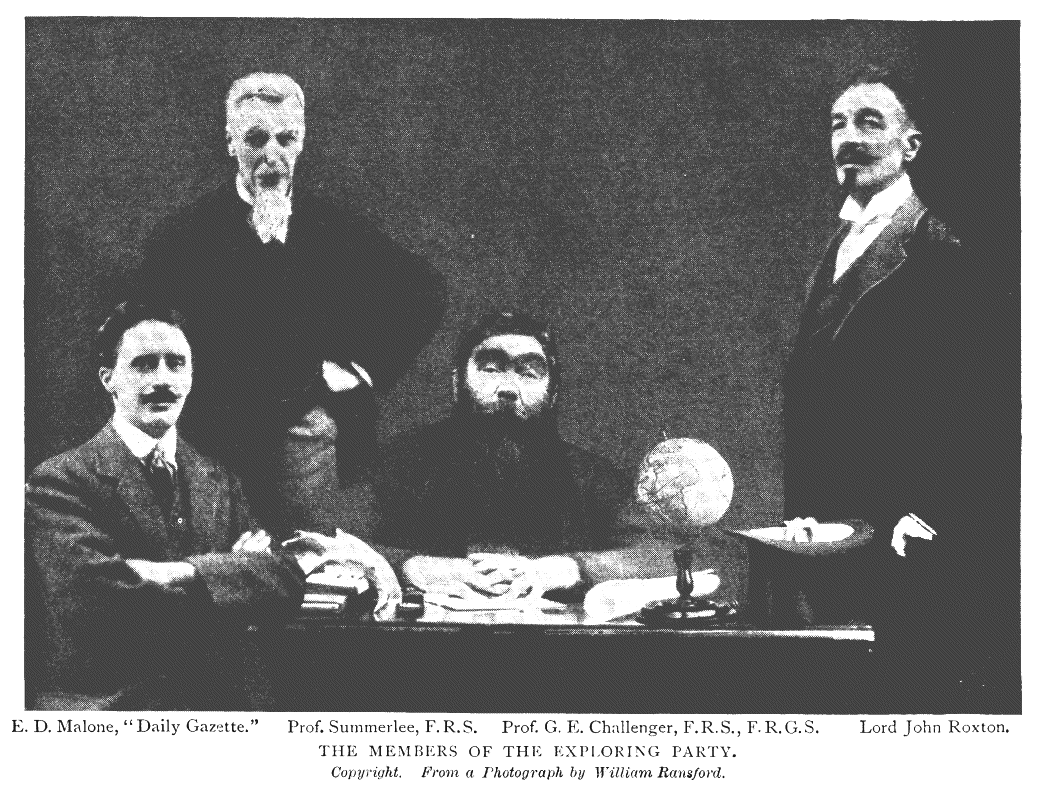 The joke-photograph from the first edition of The Lost World, showing Conan Doyle disguised as Challenger and his brother-in-law Patrick Forbes as Ned Malone
The joke-photograph from the first edition of The Lost World, showing Conan Doyle disguised as Challenger and his brother-in-law Patrick Forbes as Ned Malone
 The first movie Ned Malone depiction, by Lloyd Hughes, from the 1925 silent The Lost World, with Wallace Beery shown as Challenger
The first movie Ned Malone depiction, by Lloyd Hughes, from the 1925 silent The Lost World, with Wallace Beery shown as Challenger
"I don’t think that I am a particularly brave man,” he confesses. “I have an Irish imagination which makes the unknown and the untried more terrible than they are. On the other hand, I was brought up with a horror of cowardice and a terror of such a stigma."
When we first encounter Edward Dunn (Ned) Malone in Arthur Conan Doyle’s The Lost World, he is twenty-three years old and both plucky and modest, having rescued people in a Wigan coal explosion but without publicizing it. He is an intrepid reporter for The Daily Gazette of London, and he has to be intrepid to endure the blustering egomania of Professor George Challenger.
We meet them in 1912, when The Lost World was serialized in The Strand Magazine. Challenger introduces himself by giving Malone a black eye. Malone declines to press charges, and ends up as a member of the party to explore the Lost World in South America. He is the only reporter Challenger can stand, and stays with him in the tales that followed, actually becoming Challenger’s employee in “When the World Screamed,” one of the last two published in 1928-29 during Conan Doyle’s final years. As his news editor at the Gazette, McArdle, says: “You seem to have a sort of genius for establishing relations with people.” An Irishman, Malone played for the National Rugby Team, but he also writes poetry.
By modern journalistic standards, Malone is unprofessional; reporters today do not cover a meeting only to jump into the story themselves as participant-explorers when the speaker calls for volunteers. But Malone is very much in the mold of the Victorian era’s Henry Morton Stanley, who was on assignment for the New York Herald when he searched for and found Dr. David Livingstone in unmapped Africa in 1871. (And Malone’s boss McArdle is a Scotsman who appears modeled after James Gordon Bennett Sr., the Scottish-born founder of the New York Herald.)
Malone, both reporter and sketch artist in The Lost World, is also in the doughty mold of British reporter-illustrators like Alfred R. Waud of Harper’s and Arthur Boyd Houghton of The Graphic, who went to the United States to cover its Civil War, and the opening of the American West. A colleague of Waud’s at Harper’s, Theodore Davis, described the ingredients of a professional sketch artist: “Total disregard for personal safety and comfort; an owl-like propensity to sit up all night and a hawky style of vigilance during the day.”(Harry L. Katz and Vincent Virga, eds., Civil War Sketch Book: Drawings from the Battlefront, p. xxii.)
But Malone has another model as well: Sir Arthur Conan Doyle himself, a prolific writer who threw himself not only into sports but also occasional adventures in remote areas of the globe, such as his six months aboard an Arctic whaling ship when he was but twenty years old.
And yet there is an ominous aspect to Malone’s bravery of which Conan Doyle was surely conscious, occupied as he was with military reform issues following his Boer War service in South Africa in 1900: only two years after The Lost World came the slaughter of World War I. At the time, the war was framed as a test of courage: if you opposed fighting, you were either a traitor or a coward. While 1912 was a more innocent time, Malone’s one fear is of being accused of cowardice, a fear that compels him to take terrible risks after the shallow Miss Gladys Hungerton, whom he adores and seeks to impress, tells him she wants not just a hero, but a well-known one.
“I don’t think that I am a particularly brave man,” he confesses. “I have an Irish imagination which makes the unknown and the untried more terrible than they are. On the other hand, I was brought up with a horror of cowardice and a terror of such a stigma.” And so, he continues: “I daresay that I could throw myself over a precipice … if my courage to do it were questioned, and yet it would surely be pride and fear, rather than courage, which would be my inspiration.”
--
Michael Pollak is a member of the Baker Street Irregulars and has spent 27 years at the New York Times as a writer, editor, and columnist on the Metropolitan Desk. He now lives in Phoenix, Arizona.
-28112018165410.png)
